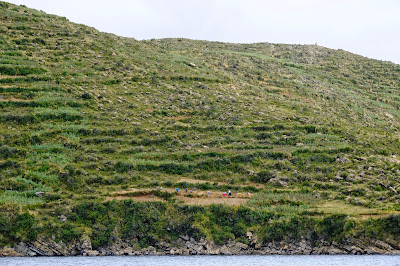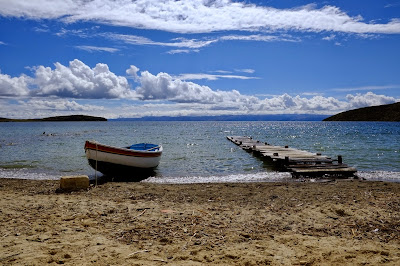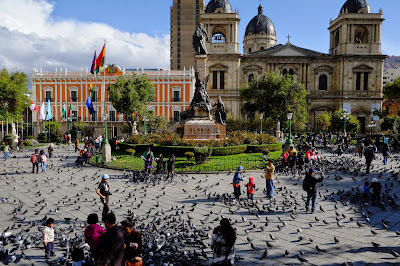The following morning I found a bus to Copacabana, which went through without a hitch.
Adios, Perú.
I shared a room that night with some people from the bus, then in the morning we got the boat to the Isla del Sol, which comes highly recommended from basically everyone, though I wasn't really sure what there was to do there until not long before we left. Boat ride there was pretty nice:
Terraces errwhere.
Lonely tree.
Lonely power pole.
Lonely yacht.
Family doin something on their lonely land.
Lonely sheepies.
When we got there, we found somewhere to stay, which was essentially someone's house with a few extra rooms. Then we went to see the ruins near the town we stayed in, a walk of some hours with nice views of the island and the lake around.
Free-range bacon anyone?
"Nothing is a mistake, everything is learning."
Back towards our village.
After we were walking around the ruins for a bit I found out they were called the Labyrinth, and they were reasonably aptly named. God knows what they actually used them for though, maybe there's an Incan Minotaur myth.
We'd seen a bunch of other tourists heading up, so spent a bit of time in the ruins wondering where the hell they were, before we literally turned a corner and saw them all.
After the ruins, we decided we'd go check out the top of the mountain on the right.
Ruins on the left somewhere; apparently there's a sunken temple in the bay somewhere.
We made the biggest tower thing. If anyone visits they should tell me if it's still there.
Back past the ruins...
... and the Table of Sacrifice. There were even some sheep waiting their turn to the side.
Half-finished houses seem to be much more common in Peru and Bolivia than I've seen anywhere else. At least this one had an occupant.
We got back to the village and realised there was basically nothing to do, so sat on the side of the lake with some beers to kill time. The view wasn't terrible. After a while some kids came up and asked if we had a football. We said no, then one appeared from somewhere and the game was on. They didn't wanna mix the teams with big and little kids, and even wanted to put money on the game. We declined. And lost (mostly I sat on the side and took photos until another kid turned up and evened the numbers. Pretty sure I was more of a liability. dat altitude and unfitness).
The lake was a problem...
In the morning, we had breakfast, and set out to walk to the other end of the island, a trip we were told takes around 3 hours.
From a school in another village on the way. Yay science!
Bit of sun-worship in front of the church.
The island's loneliest house.
When we arrived, there was a couple of hours til the next boat left, so it was beer o'clock again before going down to the dock.
"The Staircase of the Inca." We didn't go up or down it. Didn't even realise it was there til we were at the bottom of it.
A boat ride back to Copacabana (apparently it's the original, and at some point they donated a replica of the Virgin of Copacabana to Rio, who proceeded to rename their neighbourhood), then a few hectic minutes of repacking before the bus ride to La Paz.
The bus to La Paz (turns out La Paz isn't the official capital of Bolivia, but it is the administrative capital. It's not even called La Paz: it's "Nuestro Señora de La Paz," or "Our Lady of Peace." How nice.) was pretty nice, along the edge of the lake for the most part, with a short ferry ride. We arrived reasonably late, and all I had was the name of a hostel some friends I was meeting had recommended. An Ecuadorian couple told me that it'd be a waste of time telling a cabbie the name of a hostel, so I went with them to theirs to use the internet to find the actual address.
Turns out the hostel I was going to was pretty cool. They have a brewery somewhere around La Paz, so they have tasty beers in the bar attached to one of the twinned hostels. And a free beer for every night you stay ain't bad.
In the morning I went for a wander round the city with someone I met in the dorm. I quite liked La Paz, it seemed to have a lot going on. Though it is, in essence, a big Latin city, and they all seem to be reasonably similar.
The map we had had a rather large looking park on it, so we decided to start there.
Looked like a little go-kart track, but not sure what the pavilion thing in the back is.
Turns out the park was mostly this little strip of green between a couple of roads, with a fancy-pants walkway above it that was slippery when dry.
Circus was in town.
Next to the go-kart track was a little amusement park-type thing.
On the side of a big market building, which could've housed a reasonably-sized town.
I think I took this the day after Anzac Day - monument to the unknown soldier.
After the "park" we wanted to check out some museums, but it was siesta time so nothing was open. Found a nice little cafe on this street though.
Randomly walking back to the hostel we wandered past the Museum of Traditional Musical Instruments, or some such. Turns out it was really cool:
Parrot-feather decoration.
More parrot-feather decorations. Poor parrots...
Ocarinas!
Bone musician.
Erotic ocarinas!
Then the churangos (these guitar things) started. There was thousands, made of all kinds of shit.
This one's aluminium, and was made from plane fuselage by an injured soldier as a gift to his medic, in the 1930's.
Harp made of armadillo (?)
Churango made from a condor's breastbone.
Devil's churango.
Churango made from a quirquincho. Said somewhere else they're endangered, I wonder why...
We went to see if they actually made this thing, a bit later. They didn't :(
For the jester.
For your ankles, when you're dancin.
These are big.
These are bigger.
Should've used myself for scale, but meh.
Sticks for measuring where the holes should go on the pipes.
Novelty churangos (though aren't they all?).
Your double-necked guitar ain't got shit.
Sheep's-toe shaker thing.
At this point we were outside on a balcony overlooking the courtyard, and there were a load of wacky instruments we could play. No videos, sorry.
"These Bolivians must be so poor that they don't have money to buy themselves a bigger guitar."
Old piano that was played with a wee hammer.
Next were a few rooms with instruments from other countries that'd been donated to the museum over the years.
Best music box ever. Couldn't touch it though.
Weird Japanese thing.
Laúd, doesn't say what country it's from though.
Them Germans be crazy.
"Violin uke"
Raging 20's carnaval.
Then there was a room or two with all kinds of cool memorabilia.
"Admiring the master."
Actually the world's smallest violin.
All the different Andean pipes.
All the different churangos and so on.
After was a little art gallery/concert hall.
"Reaching a dream," made by local kids.
In the courtyard they had 2 parrots, Juan Sebastián Bach and José Jach'a Flores
Best buds.
Churango maker's workshop, beers'n'all.
They also had this guy lying around for some reason.
After the museum we went to see if the armadillo-shaped cultural complex had been built. All we found was a square full of pigeons. I fucking hate pigeons. These ones weren't too bad though, much nicer than the manky as fuck ones in Auckland.
That evening I met up with the friends I'd arranged to meet, Mike and Laryssa. I met Mike in Mexico and Laryssa separately in Guatemala, and now they were traveling together, so that was pretty sweet. They recommended that we visit the cemetery, a short ride away on the fancy new cable car.
Was totally not expecting what this was. The cemetery was gigantic, rows upon endless rows of 5-high spaces for ashes, each customised by the family and the vast majority with some offerings of some sort inside. Offerings usually meaning beer, soft drinks, biscuits, lollies, etc. I'd left with my camera's battery half-dead, and it's not right taking photos in a cemetery full of people, so I've just got a handful of photos from my phone. Suffice to say, you really need at least a couple of hours in this place to appreciate it.
Much fancier-than-normal area.
I really liked this (and there were many more): it's a mausoleum for the cab drivers' syndicate. I liked the sign saying that they were being evicted a little less, but I guess it's a pretty good union perk, quite a lot of the independent spaces had little bills attached to them with threat of removal.
War hero's memorial.
Mausoleum for retired teachers.
After an hour or two in the cemetery, we carried on up the cable car to El Alto, essentially another city on a cliff overlooking La Paz. When we were there the main road was basically dead, though it was huge. I was later told that on Sundays the whole road becomes a market, selling everything you could want. Unless you wanted a Bolivian soccer jersey, as the guy who told me about it did.
The second thing I stayed for was the 9th birthday party of the hostel we were in, and only then because they were bringing in chulita wrestlers. The chulitas are basically women who dress in their traditional clothes and put on a pro wrestling show. I'm told the actual shows are rather impressive. In the hostel the ring they wrestled in was a paddling pool full of spent beer malt, so I guess it was entertaining in it's own way.
The morning after, I went to cycle down the Death Road, which wasn't nearly as bad as I imagined, but I'll get to that later.

































































































































No comments:
Post a Comment